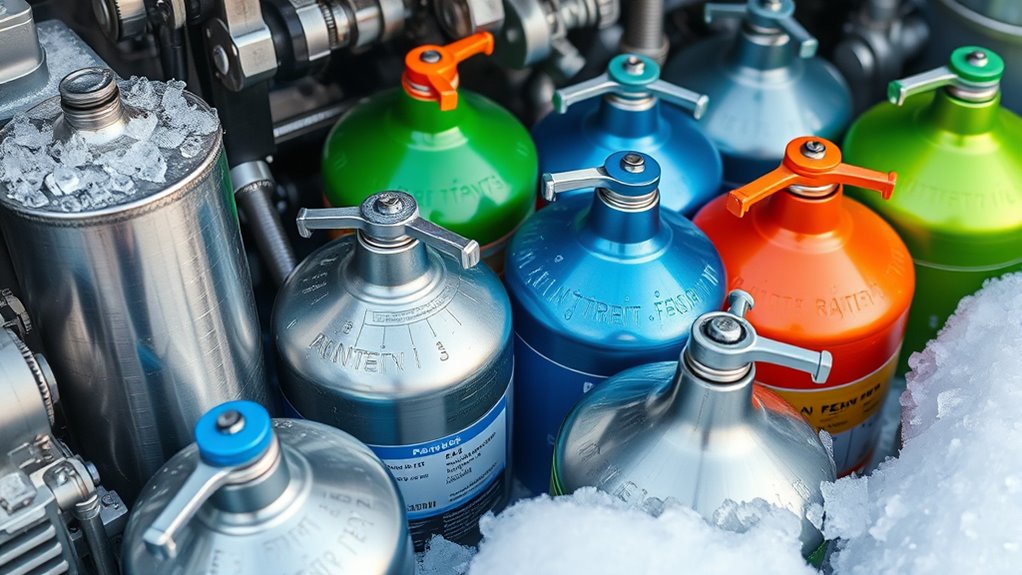When choosing a coolant for extreme temperature swings, you need one that can handle both high heat and freezing conditions without breaking down. Look for coolants with wide thermal stability ranges, like organic or glycol-based options, which resist degradation and prevent freezing or boiling. Guarantee compatibility with your system’s materials and consider environmental safety. To keep your system reliable, follow best practices and monitor coolant performance—more insights await to help you make the best choice.
Key Takeaways
- Choose coolants with wide thermal stability ranges to handle both high heat and freezing conditions effectively.
- Prioritize coolants with proven material compatibility to prevent corrosion and system damage across temperature swings.
- Use inorganic or organic coolants with low freezing points and high boiling points for reliable performance in extreme environments.
- Regularly monitor coolant quality, pH, and system integrity to prevent degradation and ensure optimal thermal management.
- Consider hybrid or specialized coolants tailored for extreme temperature fluctuations to maximize efficiency and system longevity.
Understanding the Impact of Temperature Fluctuations on Coolant Performance
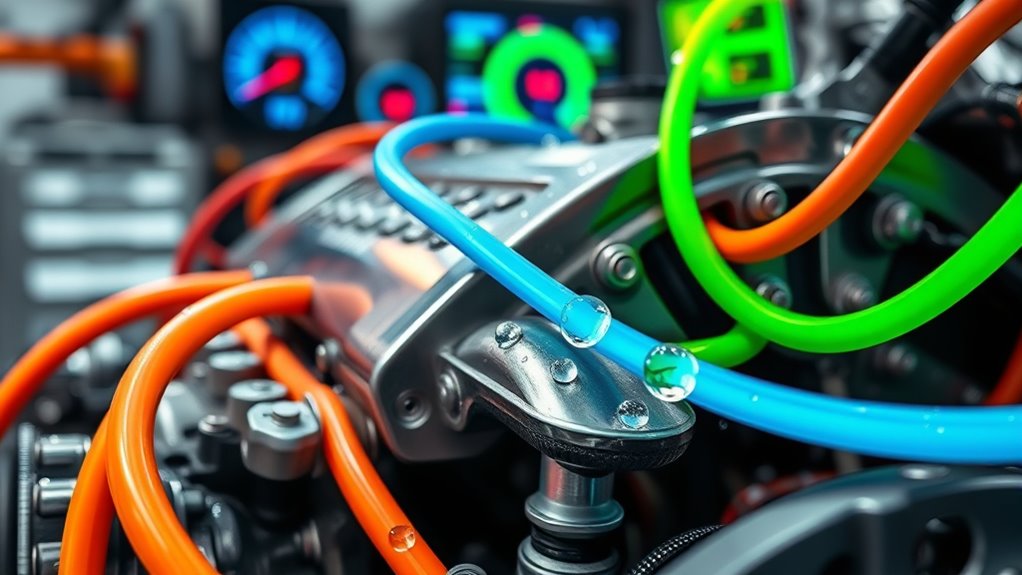
Temperature fluctuations can considerably affect how well a coolant performs in maintaining ideal engine or system temperatures. When temperatures rise, coolants must absorb and transfer heat efficiently to prevent overheating. Conversely, during cold spells, they need to prevent freezing and guarantee smooth circulation. If the coolant isn’t suited for these fluctuations, it can lead to poor temperature regulation, increased engine wear, or system failure. You’ll find that some coolants lose their effectiveness quickly outside specific temperature ranges, causing overheating or freezing issues. Understanding how temperature swings impact coolant performance helps you choose the right formulation. Proper coolant selection guarantees your system remains stable regardless of extreme weather conditions, reducing maintenance costs and prolonging equipment lifespan. Staying aware of temperature effects is essential for ideal system operation. Additionally, selecting coolants formulated with organic compounds can enhance performance stability across a wider temperature spectrum.
Types of Coolants Suitable for Wide Temperature Ranges
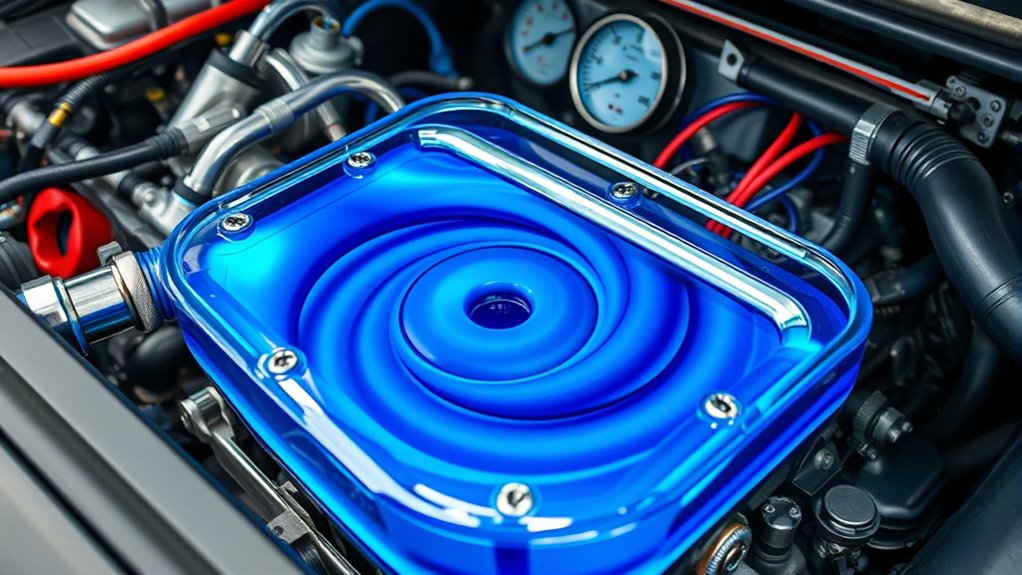
When choosing coolants for broad temperature ranges, you should consider organic options like ethylene glycol, inorganic coolants such as silicates, or hybrid solutions that combine both. Each type offers different benefits regarding stability and performance under extreme conditions. Understanding these options helps you select the most effective coolant for your specific needs. Additionally, selecting coolants compatible with your system’s materials is crucial to prevent damage and ensure longevity material compatibility.
Organic Coolants Overview
Have you considered how organic coolants can effectively cover wide temperature ranges in various systems? Organic coolants, often based on hydrocarbons or esters, are known for their excellent thermal stability and low toxicity. They perform well across extreme temperatures, making them ideal for applications with fluctuating conditions. These coolants tend to have a high boiling point and low freezing point, which helps prevent phase changes that could damage equipment. Additionally, they often provide good lubrication properties, reducing wear on components. Their thermal stability makes them particularly reliable in environments with significant temperature swings. Here are some benefits:
- Wide temperature stability
- Low environmental impact
- Good lubricating qualities
- Compatibility with various materials
Organic coolants offer a practical solution for systems facing extreme temperature swings, ensuring safety and efficiency.
Inorganic Coolant Options
Inorganic coolants, such as water, glycol-based mixtures, and molten salts, are highly effective options for systems that require wide temperature stability. Water has a high specific heat capacity, making it excellent for absorbing and transferring heat across broad temperature ranges. Glycol mixtures, like ethylene or propylene glycol, lower the freezing point and increase the boiling point, enabling operation in colder and hotter environments without freezing or boiling over. Molten salts can operate at extremely high temperatures while maintaining stability, making them suitable for specialized applications. These inorganic coolants are often chosen for their thermal properties, durability, and ability to resist chemical degradation under extreme conditions. Their broad temperature ranges make them ideal for industrial processes, energy storage, and advanced cooling systems. Additionally, coolant compatibility with various materials ensures their effectiveness and longevity in diverse applications.
Hybrid Cooling Solutions
Are hybrid cooling solutions the answer to achieving ideal thermal management across wide temperature ranges? They combine different coolants to leverage their strengths and overcome individual limitations. For example, you might use a combination of inorganic coolants with organic or phase-change materials, ensuring performance from extreme cold to high heat. This approach offers flexibility, reducing the risk of coolant failure in challenging environments. Incorporating well-being tips can also enhance system maintenance and operator health, promoting overall efficiency. This strategy ensures broader temperature applicability, enhanced heat transfer capabilities, reduced risk of corrosion or degradation, and improved system longevity.
Key Properties to Consider When Selecting a Coolant for Extreme Conditions
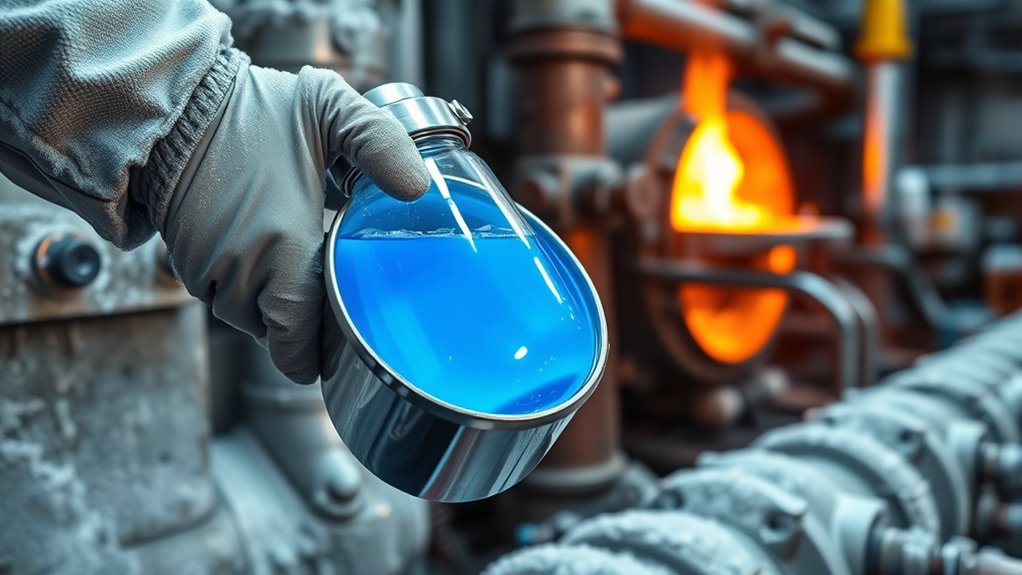
When choosing a coolant for extreme conditions, you need to consider its thermal stability range to guarantee it can handle high temperatures without breaking down. Viscosity under stress is also vital, as it affects flow and heat transfer efficiency during demanding operations. Focusing on these properties helps you select a coolant that performs reliably in harsh environments. Additionally, understanding the antioxidant properties of the coolant can prevent degradation over time, ensuring consistent performance.
Thermal Stability Range
Understanding the thermal stability range of a coolant is essential for ensuring reliable performance under extreme conditions. This range indicates the temperatures at which the coolant remains effective without decomposing or losing its protective properties. If the coolant’s stability range is too narrow, it can break down during temperature swings, causing corrosion, buildup, or system failure. To select the right coolant, consider:
- The maximum temperature it can withstand without degrading
- The minimum temperature where it remains fluid and effective
- Its resistance to thermal decomposition over time
- Compatibility with system materials at temperature extremes
- The coolant’s thermal stability range, which determines its ability to perform consistently under fluctuating temperatures
Ensuring your coolant’s thermal stability range aligns with your operating environment helps prevent failures, extends equipment life, and maintains ideal cooling performance during temperature fluctuations.
Viscosity Under Stress
Have you considered how a coolant’s viscosity changes under stress conditions? When systems operate under extreme temperatures or high pressure, coolant viscosity can fluctuate, impacting heat transfer efficiency. Under stress, some coolants thicken, making circulation more difficult and increasing pump workload. Others may thin excessively, risking inadequate lubrication and potential leaks. You need a coolant with stable viscosity across a broad temperature range and under mechanical stress. Look for fluids specifically formulated to resist viscosity changes when under load or thermal strain. Maintaining consistent viscosity ensures reliable heat removal, reduces wear on components, and prevents system failures. Understanding how your coolant behaves under stress helps you select a product that maintains performance and longevity, even in the most demanding environments.
Compatibility and Material Considerations for Coolant Systems
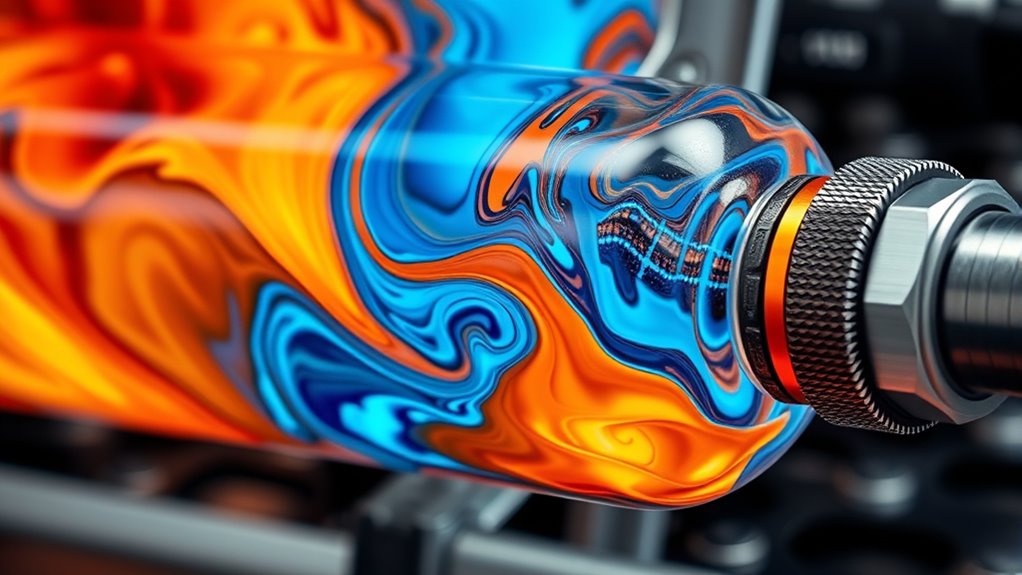
Selecting the right coolant involves ensuring compatibility with your system’s materials to prevent corrosion, degradation, or leaks. You need to take into account how the coolant interacts with metals, plastics, and seals in your system. Incompatible coolants can cause corrosion, leading to leaks or component failure. Always verify the chemical compatibility of your coolant with your system’s construction materials. Consulting performance metrics can help determine the most suitable coolant for your specific application. Prioritize compatibility to extend your system’s lifespan and maintain ideal performance.
The Role of Thermal Conductivity and Specific Heat in Coolant Efficiency
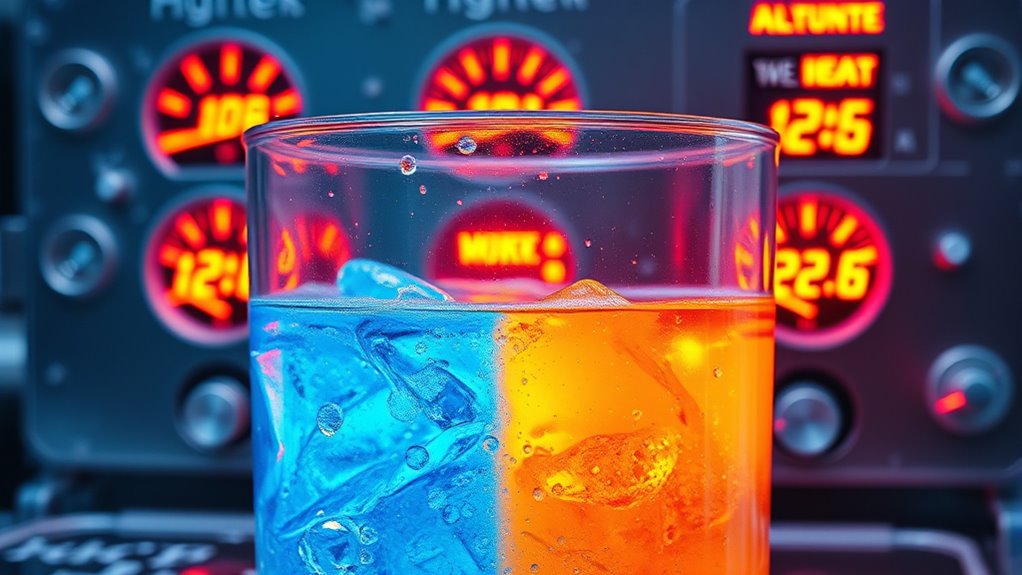
Thermal conductivity and specific heat are critical factors that determine a coolant’s ability to transfer and absorb heat efficiently. High thermal conductivity means heat moves quickly through the coolant, reducing hot spots and maintaining uniform temperatures. Specific heat indicates how much energy the coolant can absorb before its temperature rises considerably. A coolant with high specific heat can store more heat, delaying temperature increases in the system. When selecting a coolant for extreme temperature swings, prioritize materials with high thermal conductivity and specific heat to optimize heat transfer and storage. This ensures your system remains stable and efficient, even under rapid or intense temperature changes. Additionally, choosing a coolant with proper viscosity ensures smooth circulation and reduces strain on your system’s pump and components. Understanding these properties helps you choose a coolant that effectively manages thermal loads, improving performance and longevity.
Environmental and Safety Factors in Coolant Choice
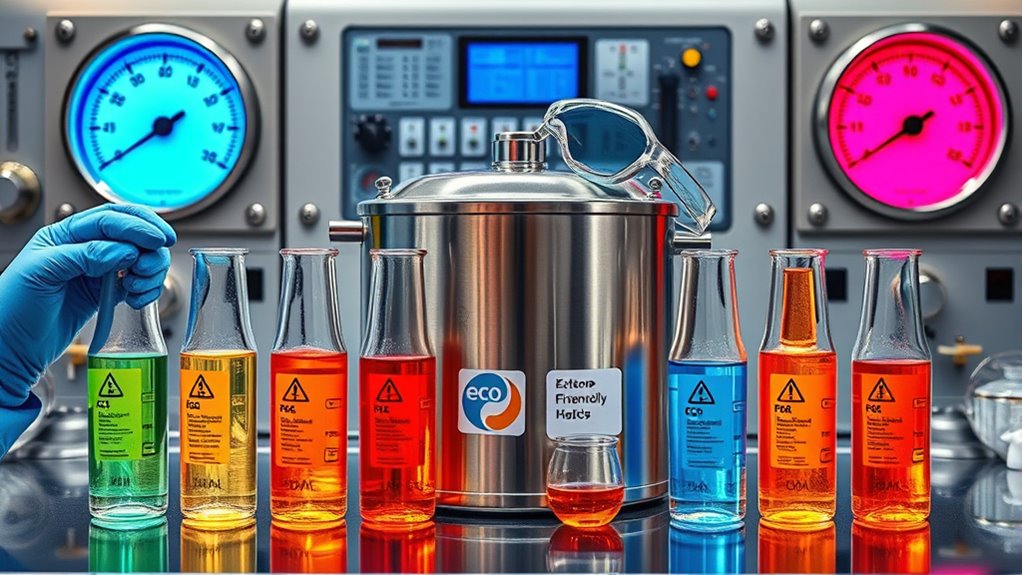
While high thermal conductivity and specific heat improve a coolant’s performance, it’s equally important to take into account its environmental impact and safety profile. You need to evaluate potential risks and long-term effects when selecting a coolant. For example, some coolants are biodegradable and have lower toxicity, reducing environmental harm. Others might pose health hazards if leaked or handled improperly. It’s also essential to consider regulations and disposal methods to prevent pollution. Additionally, safety concerns include flammability, toxicity, and volatility, which can affect both personnel and equipment. Consulting skincare product certifications can help ensure the coolant meets safety standards and environmental guidelines.
Maintenance and Monitoring of Coolant Systems in Variable Climates
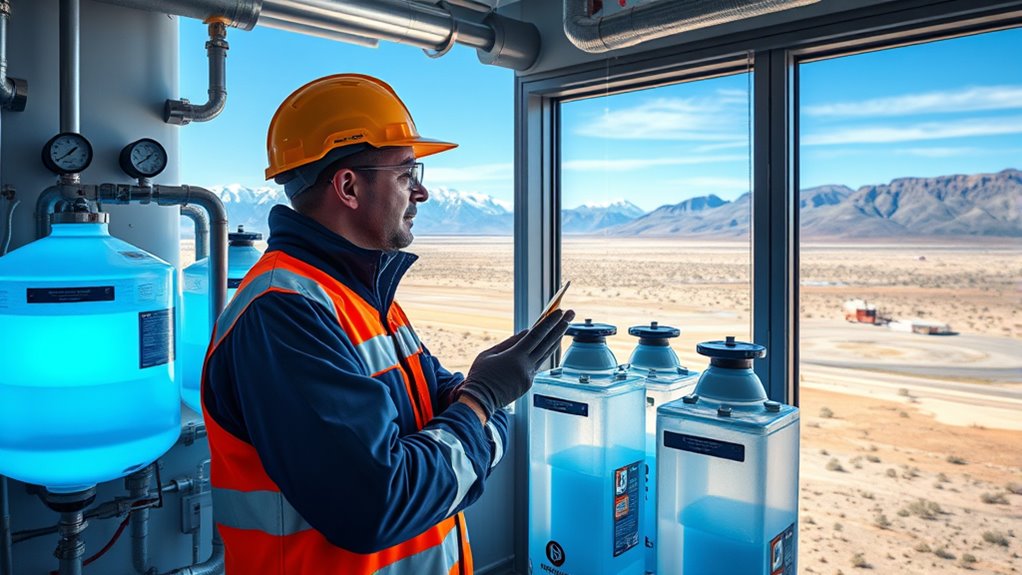
Maintaining and monitoring coolant systems in variable climates requires diligent attention to environmental changes that can affect system performance. Temperature fluctuations can cause coolant viscosity shifts, leading to inefficient heat transfer or increased wear. Regularly check coolant levels and top off as needed, especially after extreme temperature swings. Monitor for signs of contamination, such as cloudiness or sediment, and replace coolant according to manufacturer recommendations. Pay close attention to pressure and flow rates, which can fluctuate with ambient conditions. Use sensors and gauges to detect leaks or overheating early. Keep an eye on corrosion inhibitors and pH levels to prevent system degradation. Consistent inspections ensure your coolant system adapts smoothly to changing climates, maintaining excellent performance and preventing costly failures.
Best Practices for Implementing Coolants in Extreme Temperature Environments
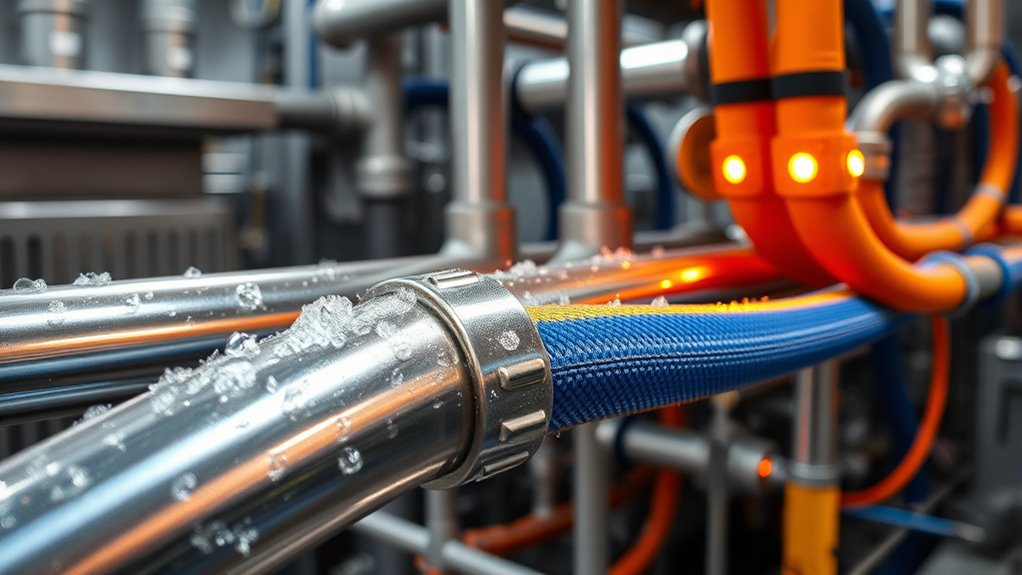
Implementing coolants effectively in extreme temperature environments demands careful selection and application practices. To succeed, you should consider the following:
- Choose coolants with high thermal stability suited for the specific temperature range.
- Ensure proper mixing ratios to prevent freezing or boiling points from being compromised.
- Use compatible materials that won’t degrade or react adversely with the coolant.
- Regularly inspect and maintain cooling systems to detect leaks or degradation early.
Frequently Asked Questions
How Do Extreme Temperature Swings Affect Coolant Longevity?
Extreme temperature swings can considerably impact your coolant’s longevity. When temperatures fluctuate rapidly, the coolant expands and contracts, causing stress on the system and accelerating breakdown. This leads to quicker degradation, reduced effectiveness, and potential system damage. To mitigate these effects, regularly check and replace your coolant, and consider using formulations designed for temperature extremes. Proper maintenance ensures your system stays protected and runs smoothly despite the temperature variations.
Are There Specific Additives to Improve Coolant Performance in Temperature Extremes?
You should consider using additives like corrosion inhibitors, stabilizers, and anti-foaming agents to enhance coolant performance in temperature extremes. These additives help prevent breakdown, reduce corrosion, and improve thermal stability, ensuring your coolant maintains its effectiveness longer. Always check manufacturer recommendations to choose compatible additives, and regularly monitor coolant condition to keep your system running smoothly through temperature fluctuations.
What Are the Signs of Coolant Failure in Fluctuating Temperatures?
Ever wondered how to tell if your coolant is failing in fluctuating temps? You might notice your engine overheating or running hotter than usual, especially during temperature swings. You could also see coolant leaks, puddles under your vehicle, or experience reduced heater performance. If your temperature gauge fluctuates or your check engine light comes on, these are signs your coolant isn’t doing its job. Stay alert to prevent costly engine damage.
How Does Coolant Viscosity Change With Temperature Variations?
You might notice that coolant viscosity decreases as temperatures rise, making it flow more easily, which helps improve heat transfer. Conversely, when temperatures drop, the coolant thickens, increasing viscosity and potentially reducing flow. This change affects how well your cooling system works, so it’s important to choose a coolant formulated to maintain ideal viscosity across temperature ranges. Proper coolant selection ensures your system stays efficient, regardless of temperature fluctuations.
Can Traditional Coolants Be Used for Rapid Temperature Cycling Applications?
They say a chain is only as strong as its weakest link, and that’s true for coolants in rapid temperature cycling. You can use traditional coolants, but they may not perform well under quick changes. They might not transfer heat efficiently or could break down faster. For best results, consider specially formulated coolants designed to handle rapid temperature swings, ensuring your system stays protected and efficient.
Conclusion
Choosing the right coolant for extreme temperature swings isn’t just about specs—it’s about anticipating the unexpected. As conditions become more unpredictable, your system’s performance hinges on your choices. Will your coolant withstand the test of time and temperature? Stay vigilant, monitor closely, and be ready to adapt. The next challenge could be just around the corner. Are you prepared to keep your system running smoothly no matter what the environment throws at you?
